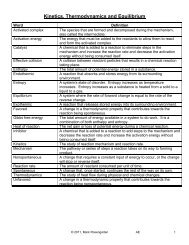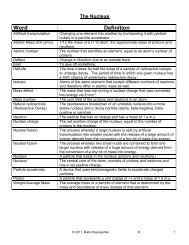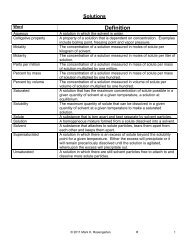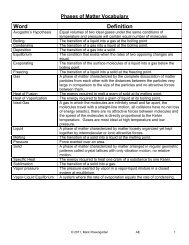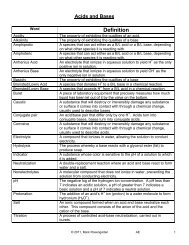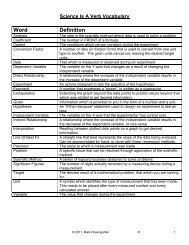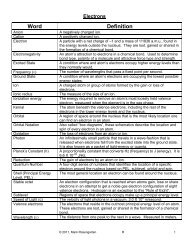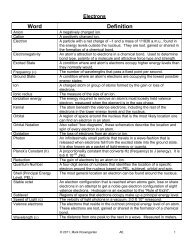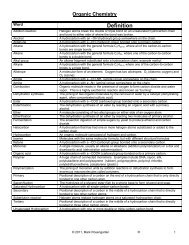Unit 6: Periodic Table and Bonding - Mark Rosengarten
Unit 6: Periodic Table and Bonding - Mark Rosengarten
Unit 6: Periodic Table and Bonding - Mark Rosengarten
Create successful ePaper yourself
Turn your PDF publications into a flip-book with our unique Google optimized e-Paper software.
SUMMING IT ALL UP<br />
Bond Bonded END Substance How the bond forms<br />
Type Elements<br />
is called<br />
Ionic M – NM 1.7 + Ionic • Metal atom (low EN) loses e - to nonmetal atom (high EN)<br />
• Metal is OXIDIZED, nonmetal is REDUCED<br />
• Metal atom forms + ion, nonmetal atom forms – ion<br />
• Oppositely charged ions attract<br />
• The attraction between the ions is the ionic bond<br />
Covalent NM – NM 0 – 1.7 Molecular NONPOLAR COVALENT<br />
• Two nonmetal atoms with an END of 0 – 0.4 share their unpaired<br />
valence electrons EVENLY<br />
• No oppositely charged ends<br />
More facts about bonding:<br />
POLAR COVALENT<br />
• Two nonmetal atoms with an END of 0.5 or higher share their<br />
unpaired valence electrons UNEVENLY<br />
• The atom with the lower electronegativity develops a slightly<br />
positive charge (δ+)<br />
• The atom with the higher electronegativity develops a slightly<br />
negative charge (δ-)<br />
Ionic • Forms ionic crystal lattices with very high melting <strong>and</strong> boiling points<br />
• Electricity is conducted by charged particles.<br />
• The ionic bond breaks when the compound is melted or dissolved in water<br />
• Breaking the bonds forms ions that are capable, like all liquid particles, of flow<br />
• Ionic liquids <strong>and</strong> solutions are good conductors of electricity<br />
• Ionic solids cannot conduct electricity, since the ions are locked in a crystal lattice <strong>and</strong> are not free to<br />
move around<br />
Covalent • Molecules are particles made up of covalently bonded nonmetal atoms<br />
• Since no ions are formed, molecular substances will never conduct electricity (exception to follow<br />
much later in the course)<br />
• Molecules can have partially charged ends, like a magnet, thanks to polar covalent bonds. Since<br />
these partially charged ends have much less charge than ions do, molecular substances have low<br />
melting <strong>and</strong> boiling points<br />
• The attraction of the δ + end of one molecule for the δ - end of another is called an intermolecular<br />
attractive force<br />
• This attractive force is what causes water to have surface tensionso insects can walk across it <strong>and</strong><br />
so it can form a meniscus when a cup of water is slightly overfilled<br />
• Atomic orbitals in each bonded atom combine in such a way that the shared electrons belong to both<br />
of the bonded atoms <strong>and</strong> form molecular orbitals.<br />
© 2011, <strong>Mark</strong> <strong>Rosengarten</strong> AE 15



